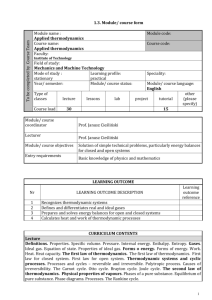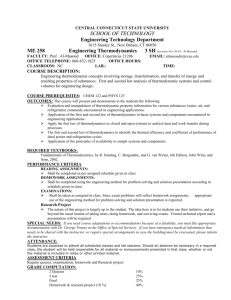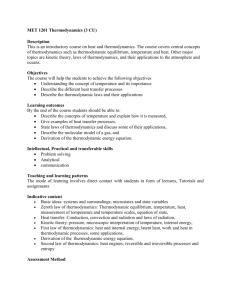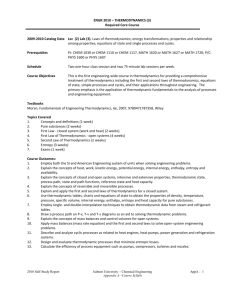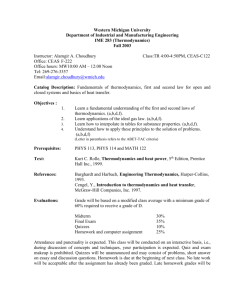Thermodynamics
advertisement
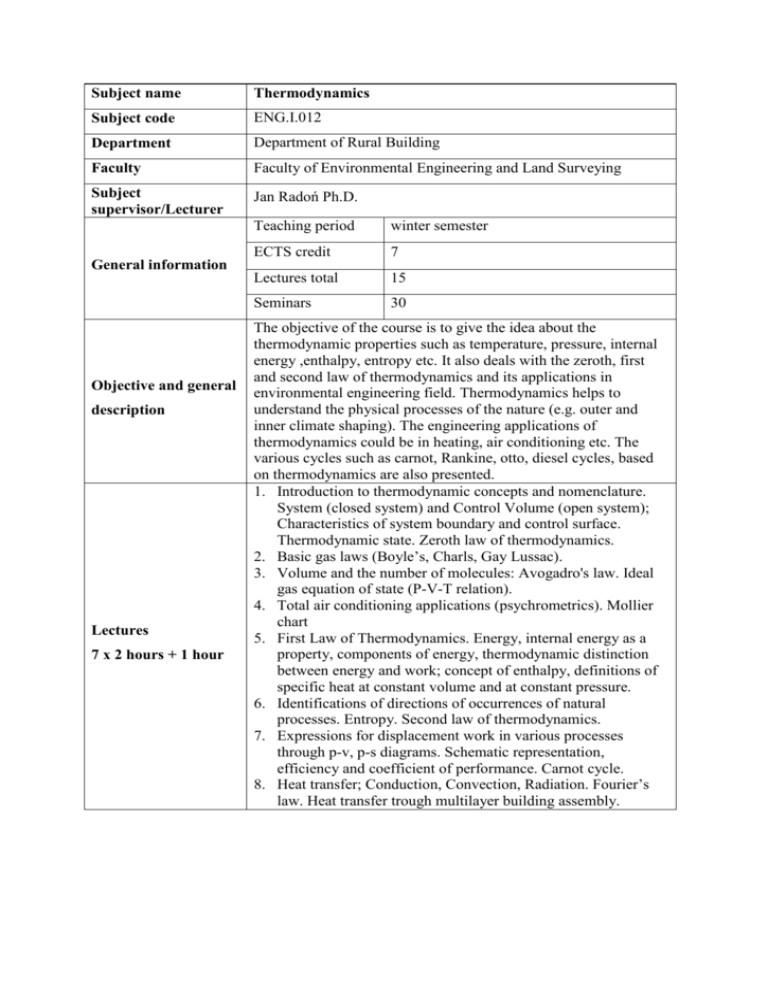
Subject name Thermodynamics Subject code ENG.I.012 Department Department of Rural Building Faculty Faculty of Environmental Engineering and Land Surveying Subject supervisor/Lecturer Jan Radoń Ph.D. Teaching period winter semester ECTS credit 7 Lectures total 15 Seminars 30 General information Objective and general description Lectures 7 x 2 hours + 1 hour The objective of the course is to give the idea about the thermodynamic properties such as temperature, pressure, internal energy ,enthalpy, entropy etc. It also deals with the zeroth, first and second law of thermodynamics and its applications in environmental engineering field. Thermodynamics helps to understand the physical processes of the nature (e.g. outer and inner climate shaping). The engineering applications of thermodynamics could be in heating, air conditioning etc. The various cycles such as carnot, Rankine, otto, diesel cycles, based on thermodynamics are also presented. 1. Introduction to thermodynamic concepts and nomenclature. System (closed system) and Control Volume (open system); Characteristics of system boundary and control surface. Thermodynamic state. Zeroth law of thermodynamics. 2. Basic gas laws (Boyle’s, Charls, Gay Lussac). 3. Volume and the number of molecules: Avogadro's law. Ideal gas equation of state (P-V-T relation). 4. Total air conditioning applications (psychrometrics). Mollier chart 5. First Law of Thermodynamics. Energy, internal energy as a property, components of energy, thermodynamic distinction between energy and work; concept of enthalpy, definitions of specific heat at constant volume and at constant pressure. 6. Identifications of directions of occurrences of natural processes. Entropy. Second law of thermodynamics. 7. Expressions for displacement work in various processes through p-v, p-s diagrams. Schematic representation, efficiency and coefficient of performance. Carnot cycle. 8. Heat transfer; Conduction, Convection, Radiation. Fourier’s law. Heat transfer trough multilayer building assembly. Seminars 15 x 2 hours References 1. Basic thermodynamics’ definitions. Units and conversions. 2. Applying thermodynamic properties using Boyle’s, Charls and Gay Lussac’s law. 3. Calculations of gas parameters using equations of state for an ideal gas. Representation of various processes on P-v diagram. 4. Calculation of work done in various thermodynamic processes. 5. Calculation of enthalpy in solids, fluids and gas. 6. Determination the properties of dry air-water vapor mixtures, plot processes on a psychrometric chart, and analyze processes involving dry air-water vapor mixtures to perform energy and mass balances. 7. Applications of the conservation of mass, conservation of energy, and the first law of thermodynamics. 8. Review. First quiz. 9. Calculation of entropy in closed and open systems. Plot T-s diagrams. 10. Discussing of Applications of second law of thermodynamics. 11. Representation of common ideal power generation cycles (carnot, Rankine, otto, diesel cycles) on P-v, T-s diagrams. Calculation of possible and useful work; calculation of cycle efficiency. 12. Analyzing of refrigeration and heat pump systems, including single and multistage vapor compression cycles, and gas refrigeration cycles. 13. Basic modes of heat transfer; conduction, convection and radiation, and their application to simple situations. 14. Calculation of heat transfer through multilayer building assembly. Temperature diagram by steady-state heat flow. Calculation of heat loss from thermal insulated pipes. 15. Review, Second quiz. Van Ness H. C.: Understanding thermodynamics. McGraw-HillBook, New York, USA, 1969, 103 pp. Potter C., Somerton W.: Thermodynamics for engineers. Second edition. McGraw-Hill-Book, New York, USA, 2006, 406 pp.

